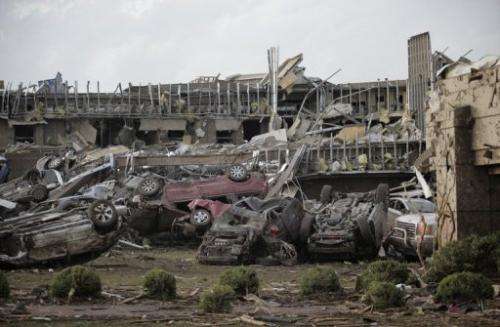Flipped vehicles are piled up outside the heavily damaged Moore Medical Center after a powerful tornado ripped through the area on May 20, 2013 in Moore, Oklahoma.
Tornados, among the most violent of atmospheric storms, rarely reach the size and brutality of the twister that swept through an Oklahoma City suburb on Monday, experts say.
And seldom do they hit built-up areas.
"Typically, they could be about 100 metres (110 yards) across, and they last maybe five to ten minutes on the ground," according to University of Reading meteorologist Ross Reynolds—who said the people of Moore were in many ways unlucky.
They were confronted by a two-mile- (three-kilometre) wide storm that lasted about 45 minutes and was of a similar strength to the worst-ever tornado that hit the area 14 years ago but claimed fewer lives.
"It is bad luck that a tornado goes in a populated area, normally it is agriculture land... crops or farm buildings," said Reynolds.
"It is a horrible thing when they go through the cities—the chances of that happening are very small"—especially in such a sparsely populated region.
Revising a previous higher toll, officials said Tuesday that at least 24 people, including nine children, had died in the Oklahoma storm that packed winds of 166 to 200 miles per hour (267-322 kilometres per hour).
Tornados are spinning columns of air that touch the ground from massive cumulonimbus thunderstorm clouds.
They occur in regions of most continents except for the very coldest areas, and are also common in Argentina and Bangladesh.
The UK is said to get more tornadoes per square kilometre than the United States, but the central and southern American states of Texas, Oklahoma and Kansas get the most violent ones due to unique geographical and meteorological conditions.
Dubbed "Tornado Alley", this is where winds of widely varying temperatures—warm and moist from the Gulf of Mexico, hot and dry from the desert and cool and dry from the Rocky Mountains and northern plains—meet in volatile, potent storm clouds called "supercells" that can explode as tornadoes within half an hour from birth.
Most storms occur from May to June, and mainly between 4 pm and 9 pm, according to the US National Oceanic and Atmospheric Administration.
Tornado Alley can see three or four tornados per day in the high season, or about 1,200 for the entire country per year, but only about two percent reach dangerous levels with winds exceeding 265 kph and most of these hit land in rural areas.
According to Reynolds, weather conducive to tornado formation can be predicted a day in advance.
Local forecasters can then keep a careful eye on satellite and radar pictures of cloud- and rain-formation—send out tornado-spotters to find the storms and estimate their speed and destination.
This allows officials to issue a 15-20-minute warning, hopefully enough time to dive into a tornado centre.
Experts say accurate records are too young and tornadoes too small and sporadic to predict whether they are likely to be impacted by climate change.
There was no proof that they were becoming more frequent or severe, said Reynolds.
"Climate models are currently unable to resolve small-scale phenomena such as tornadoes, and no models exist which can use climate model data to predict future tornado activity," said the UK Met Office.
But Andrew Barrett, also from the University of Reading, said warmer, moister conditions should "provide more energy for the types of storms that produce tornadoes in a warmer climate."
© 2013 AFP























